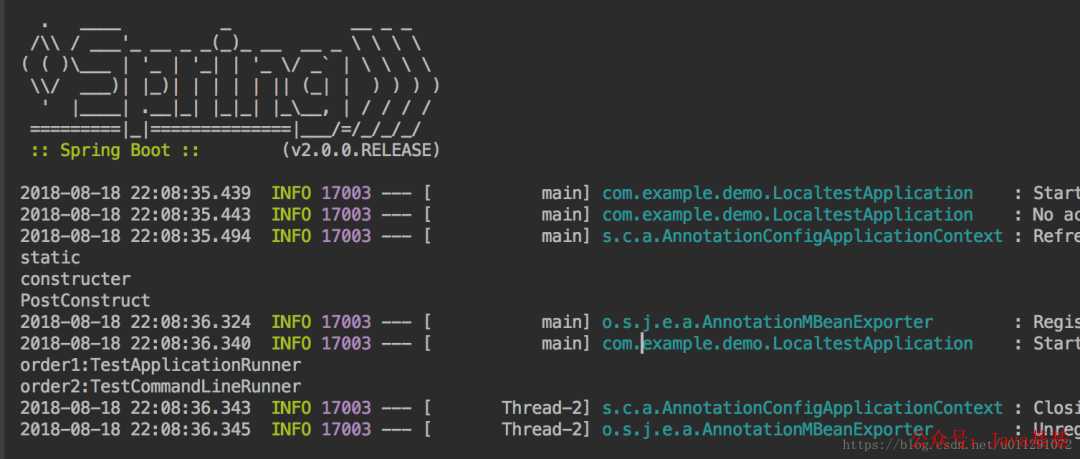

SpringBoot如何实现启动过程中执行代码
描述
目前开发的SpringBoot项目在启动的时候需要预加载一些资源。而如何实现启动过程中执行代码,或启动成功后执行,是有很多种方式可以选择,我们可以在static代码块中实现,也可以在构造方法里实现,也可以使用@PostConstruct注解实现。
当然也可以去实现Spring的ApplicationRunner与CommandLineRunner接口去实现启动后运行的功能。在这里整理一下,在这些位置执行的区别以及加载顺序。
java自身的启动时加载方式
static代码块
static静态代码块,在类加载的时候即自动执行。
构造方法
在对象初始化时执行。执行顺序在static静态代码块之后。
Spring启动时加载方式
@PostConstruct注解
PostConstruct注解使用在方法上,这个方法在对象依赖注入初始化之后执行。
ApplicationRunner和CommandLineRunner
SpringBoot提供了两个接口来实现Spring容器启动完成后执行的功能,两个接口分别为CommandLineRunner和ApplicationRunner。
这两个接口需要实现一个run方法,将代码在run中实现即可。这两个接口功能基本一致,其区别在于run方法的入参。ApplicationRunner的run方法入参为ApplicationArguments,为CommandLineRunner的run方法入参为String数组。
何为ApplicationArguments
官方文档解释为:
Provides access to the arguments that were used to run a SpringApplication.
在Spring应用运行时使用的访问应用参数。即我们可以获取到SpringApplication.run(…)的应用参数。
Order注解
当有多个类实现了CommandLineRunner和ApplicationRunner接口时,可以通过在类上添加@Order注解来设定运行顺序。
代码测试
为了测试启动时运行的效果和顺序,编写几个测试代码来运行看看。
TestPostConstruct
@Component
public class TestPostConstruct {
static {
System.out.println("static");
}
public TestPostConstruct() {
System.out.println("constructer");
}
@PostConstruct
public void init() {
System.out.println("PostConstruct");
}
}
TestApplicationRunner
@Component
@Order(1)
public class TestApplicationRunner implements ApplicationRunner{
@Override
public void run(ApplicationArguments applicationArguments) throws Exception {
System.out.println("order1:TestApplicationRunner");
}
}
TestCommandLineRunner
@Component
@Order(2)
public class TestCommandLineRunner implements CommandLineRunner {
@Override
public void run(String... strings) throws Exception {
System.out.println("order2:TestCommandLineRunner");
}
}
执行结果

总结
Spring应用启动过程中,肯定是要自动扫描有@Component注解的类,加载类并初始化对象进行自动注入。加载类时首先要执行static静态代码块中的代码,之后再初始化对象时会执行构造方法。
在对象注入完成后,调用带有@PostConstruct注解的方法。当容器启动成功后,再根据@Order注解的顺序调用CommandLineRunner和ApplicationRunner接口类中的run方法。
因此,加载顺序为static>constructer>@PostConstruct>CommandLineRunner和ApplicationRunner.
原文标题:SpringBoot 启动时自动执行代码的几种方式,还有谁不会??
文章出处:【微信公众号:Android编程精选】欢迎添加关注!文章转载请注明出处。
- 相关推荐
- 热点推荐
- JAVA
- 代码
- spring
- SpringBoot
-
Linux内核启动过程和Bootloader(总述)2012-08-18 2893
-
双向可控硅电机启动过程中无法关断 ,帮我看看啥原因2017-01-05 7757
-
uboot启动过程中延时修改2019-11-01 2604
-
单片机的启动过程是怎样的2021-11-29 1291
-
国产300MW机组中压缸启动的特点及启动过程2017-10-14 1324
-
Linux基础命令之Linux启动过程详解2017-10-18 1301
-
pxe远程启动过程分析2017-11-20 8201
-
详解bootloader的执行流程与ARM Linux启动过程分析2017-12-21 11182
-
stm32启动过程2021-12-16 909
-
STM32启动过程分析2021-12-23 834
-
linux内核启动过程会执行用户空间的init进程2022-10-14 1770
-
STM32H7的启动过程分析2022-10-17 3108
-
详解STM32启动过程2022-11-14 2309
-
ATF的启动过程介绍2023-11-07 2379
-
logd的启动过程和内容2023-11-23 1763
全部0条评论

快来发表一下你的评论吧 !

